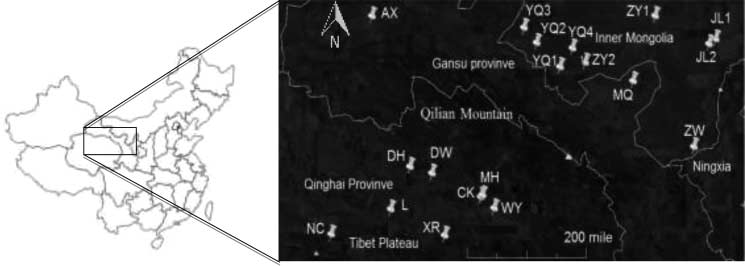We first measured the δ13Cand δ15Nvalues of root holoparasite Cynomorium songaricum and its hosts from 19 sites across four provinces in northwest China, in an attempt to investigate their nutritional relationship at the Tibetan plateau and the surrounding Gobi desert. Our study showed that the δ13C of C. songaricum closely mirrored the values of its hosts, Nitraria tangutorum and N. sibirica across all sampling sites. C. songaricum was significantly depleted in 13C compared to host plants at the Tibetan plateau, showing an average parasite/host δ13C difference of −0.6 ‰. In contrast, 15N of C. songaricum was significantly enriched by +1.3‰compared to the hosts, implying that these holoparasites had other nitrogen resources. Although no difference in the δ13C and δ15N values between holoparasites and hosts was detected, the δ13C and δ15N values of holoparasites were significantly correlated with those of their hosts at the Gobi desert. The δ13C versus δ15N values were significantly but negatively correlated for the hosts; however, holoparasite/host variation in δ13C was not correlated with the variation in δ15N. The δ13C versus δ15N values were negatively correlated in C. songaricum, and this relationship tended to be magnified along the increasing elevations independent of the host plants. C. songaricum at the Tibetan plateau exhibited different δ13C and δ15N signatures compared with those at the Gobi desert. Furthermore, both δ13C and δ15N values of C. songaricum and its host plants in salt marshes at the Tibetan plateau were different from those in sand sites at the Tibetan plateau and the Gobi desert. Our results indicate that the isotopic difference depends on the different altitudes and habitats and is host-specific.

Figure . Map of sample collection across the Tibetan plateau and the surrounding Gobi desert. The characteristics of
sites and IDs are listed in Table 1. Samples were collected from four provinces or autonomous regions: Qinghai province,
Gansu province, Inner Mongolian autonomous region, and Ningxia Hui autonomous region.
Additional Information:
1. Author Information: YueqinYang, XianfengYi, Min Peng and Yubi Zhou
Correspondence:pengm@nwipb.ac.cn
2. Published : Isotopes in Environmental and Health Studies 2012, 1–11, iFirst
